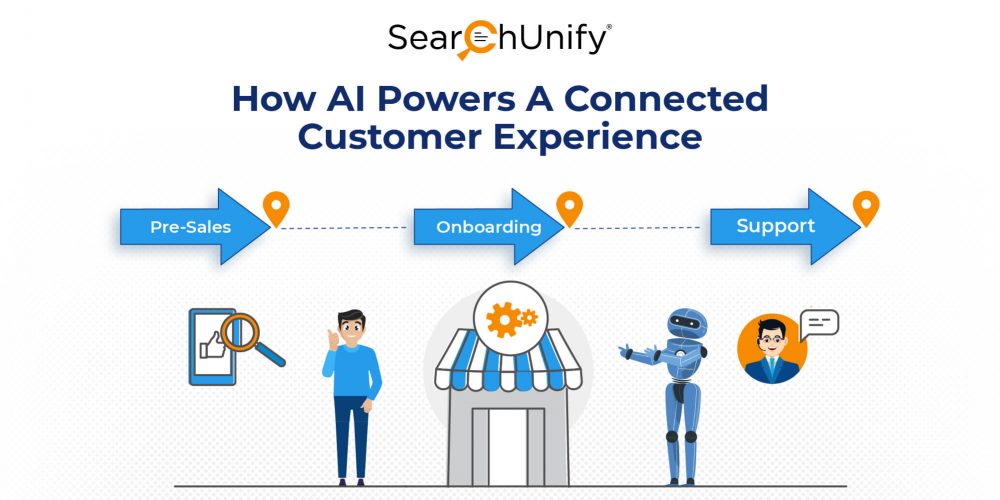
Contrary to the popular belief, customer experience isn’t a destination, but rather an ongoing journey. The journey commences the moment a prospect interacts with the brand. While every company has its own path to cover to meet the specific customer needs, the following three stages are usually a part of each customer journey — Presales, Onboarding, and Support.
The success mantra of enabling great customer experiences is to optimize processes and interactions across all touchpoints at all the three stages in a consistent and customer‑centric way. Alas, most of the companies fail to understand the significance of a connected customer experience and make the blunder of keeping the three common stages of the customer journey segmented.
In this blog post, we’ll walk you through how AI and cognitive technology automate processes and optimize interactions across all touchpoints to power connected experience across different teams at different stages. Let’s get rolling.
Stage 1: Pre‑Sales
It is the initial and make‑it‑or‑break‑it stage of the customer journey. Since customers take stock of multiple options before selecting the best possible solution at this stage, you cannot afford to goof up — one wrong impression of the brand and all your efforts go down the drain.
As per Harvard Business Review, companies with strong pre‑sales capabilities consistently achieve average win rates of 40–50% in new business and 80–90% in renewal business.
The pre‑sales stage is all about discovering exactly what the customer is looking for and what their unique challenges are. Before connecting with your pre‑sales team, the customer is likely to evaluate your product and services by analyzing your social media presence, checking out the degree of influence of your landing pages and ads, and assessing the third‑party review sites. Therefore, a unified brand experience is non‑negotiable to the success of each opportunity and the overall sales organization.
This is where cognitive technology comes into play. Powered by NLP, semantic search, and text mining; cognitive solutions learn from each digital interaction to gauge customer sentiments and detect trends. Moreover, they connect digital footprints left behind by customers while evaluating the product and services to deliver personalized collaterals.
Content personalization is the stepping stone to building a unified brand experience.
Since each company has its own set of challenges, a one‑UI‑fits‑all strategy won’t work well; and creating personalized UI for each customer demands plenty of resources. Again, cognitive technology will come to your rescue — based on the prospect’s digital interactions across touchpoints and browsing history, it creates personalized and dynamic interfaces for navigation; cutting down the number of clicks to access the right collateral and promoting authentic and interactive communication.
Last but not the least, AI reconciles all the prospect interactions with knowledge graphs. A KG helps create an easily readable set of facts that empowers both customers and employees to access the most relevant information in a jiffy. So, in case customers are unable to self‑serve, employees save their day by providing them the information they are looking for without prolonged wait times.
Customization is the new black and a touch of it in your pre‑sales strategy helps you race past your sales target. AI models excel at extracting real‑time insights from massive datasets, leading to automated content personalization.
Stage 2: Customer Onboarding
Once you welcome your customers aboard, living up to their expectations is quintessential. Else, be prepared to bear the brunt of high customer attrition. Needless to say that you’ve created an amazing portfolio of products and services for your customers. However, bombarding them with the entire portfolio at once can have catastrophic effects. All you need to do is provide a little hand‑holding so that your customers enjoy every bit of your product portfolio throughout their journey and rest assured that they’ll stay loyal towards you forever.
Information overload can lead to a paralysis of analysis, ruining the entire customer experience and tarnishing the brand image.
Cognitive tools guide users by making relevant content recommendations based on their maturity, role, product journey, etc. for an elevated product experience. For example, a new customer’s UI will display content such as guided tours for beginners, FAQs on getting started, etc. However, as the user progresses in their product journey, the content complexity increases. Let’s say after 30 days, the UI would display content like a guide for advanced users, advanced analytic tools, etc. Additionally, cognitive software is capable of identifying in real time whenever a user gets stuck while navigating your product and auto‑recommends the right content to overcome the challenge.
“One customer, well taken care of, could be more valuable than $10,000 worth of advertising.” – Jim Rohn
Stage 3: Support
Support reps are often customers’ first — and sometimes their only — human interaction with a company. Therefore, even the slightest feeling of neglect creeps up on customer relationships, costing you a fortune. As your customer base grows, paying undivided attention to each customer becomes cumbersome — It demands more efforts and headcount to fuel engagement and manage it.
As per a research by NewVoiceMedia, $84B has been lost by the U.S. companies and $338.5B has been lost worldwide annually as a result of poor customer service.
The AI‑powered chatbots will bail you out. With a deep understanding of the customer journey and emotions, NLP‑powered bots successfully map out and program bot conversations for contextual support interactions. They resolve L1 queries without any human involvement, freeing up support reps for high‑value engagements and other complex queries.
In case the query is complex enough to be resolved by a virtual assistant, cognitive technology also offers applications like Agent Helper that arm your support reps with a virtual agent to heighten efficiency & resolve customer queries faster, providing superior service interactions. By curating a list of top KB articles that helped resolve similar cases and identifying the best SMEs for help, Agent Helper reduces the Mean Time To Resolution (MTTR). After all, the clock is always ticking for your reps.
Want to know more about the experience‑enhancing AI and cognitive technology?
Customer experience is an evolving and ongoing journey, one that you are never done with. To know more about how AI helps you keep pace with the evolving customer expectations, register for our upcoming session Breaking the Fourth Wall: Next‑Gen Self‑Service Applications for Better CX at TSIA Interact Conference. Gain an in‑depth understanding of how cognitive technology helps you delight your customers as Alok Ramsisaria, CEO, Grazitti Interactive and Vishal Sharma, CTO, SearchUnify, shed light on the next‑gen self‑service apps that help you redefine your customer experience.



















